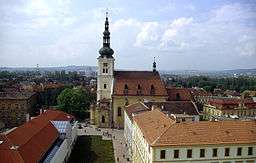Vyškov
| Vyškov | |||
| Town | |||
 | |||
|
|||
| Country | Czech Republic | ||
|---|---|---|---|
| Region | South Moravian | ||
| District | Vyškov | ||
| Commune | Vyškov | ||
| Elevation | 254 m (833 ft) | ||
| Coordinates | CZ 49°16′N 16°59′E / 49.267°N 16.983°ECoordinates: CZ 49°16′N 16°59′E / 49.267°N 16.983°E | ||
| Area | 50.40 km2 (19.46 sq mi) | ||
| Population | 21,312 (1.1.2015) | ||
| Density | 423/km2 (1,096/sq mi) | ||
| First mentioned | 1141 | ||
| Mayor | Petr Hájek | ||
| Timezone | CET (UTC+1) | ||
| - summer (DST) | CEST (UTC+2) | ||
| Postal code | 682 01 | ||
  Location in the Czech Republic | |||
| Wikimedia Commons: Vyškov | |||
| Statistics: statnisprava.cz | |||
| Website: www.vyskov-mesto.cz | |||
Vyškov (Czech pronunciation: [ˈvɪʃkof]; German: Wischau) is a town in the South Moravian Region of the Czech Republic. It has about 22,300 inhabitants.
History
By the middle of the 14th century, pest epidemics and starvation had virtually depopulated the entire area. The Catholic Church, the owners of the lands, administrated their properties via its cloisters in Bamberg, Augsburg and Brixen. These cloisters called upon German farmers to resettle the place. In those days the German language area comprised about 60 villages. But only 8 of these, with a total of about 3500 inhabitants, still existed before the eviction of the Germans after the World War II.
The inhabitants were mostly farmers. Their lives consisted mainly of hard work. The population was Roman Catholic. Therefore, the rhythm of life was mainly governed by the church and its festivities. An education in a German school was considered to be of great importance. Six villages had their own German elementary school and the town of Lissowitz even had a grammar school.
Peculiarities
The geographic separation from other German settlements was the reason why that their language could, to a great extent, retain its original form. It is a variety of a Southern German dialect. One peculiarity is that a "w" was pronounced very much like a "b." The farmhouses were built on both sides of a common green area. They consisted of one storey structures with thatched roofs. A salient part of its architecture was the two storey entrance. Stables and other dependences were built in a rectangle around a courtyard on the back of the farmhouse. The women's dresses were very colorful and they displayed a great many handmade embroideries. A striking feature was the stiffly starched, frilled collar called "Tatzl."
The Wischauer people today
After their eviction following the end of the Second World War, in 1945–1946, the former inhabitants of the language island found new homes in Germany, Austria and in other countries. In 1949 an association, "Language Island of Wischau," was formed in the German town of Aalen in order to help the scattered families move together again.
Tourist attractions
In 2006 "Dinopark" - new attraction - was opened for the public. It is located about 2.5 kilometres (1.6 miles) off the city in former "Marchanice" park. There are currently around 30 life-size dinosaur models to be seen and it is one of the most visited attractions in the area.
Sport
Most popular sport in Vyškov is rugby. Team RC Vyškov is one of the best rugby teams in Czech Republic.
Famous people born in Vyškov
- Andreas Zelinka (1802–1868) - the mayor of Vienna in 1851 - 1860.
- Alois Musil - (1868 Vyškov-Rychtářov – 1944) - an Austrian-Czech theologist, orientalist, explorer and writer.
- Klement Gottwald - (1896 Vyškov-Dědice - 1953) - communist politician, president of Czechoslovakia in 1948 - 1953.
- Otto Planetta - (1899–1934) - fascist Austrian politician who murdered Austrian Chancellor Engelbert Dollfuss.
- Karel Kachyňa - (1924–2004) - popular Czech film director.
- Albert Rusnák (1994-)
Wischau in literature
War and Peace, by Leo Tolstoy. See Book 3 Chapters 10 and 11.
Krambambuli, by Marie von Ebner-Eschenbach, a short story part of Dorf- und Schloßgeschichten (Village and castle stories).
International relations
Twin towns — Sister cities
Vyškov is twinned with:
References
- Notes
- ↑ "Jarosław Official Website - Partner Cities".
 (in Polish) © 2008 Urząd Miasta Jarosław. Ul. Rynek 1, 37-500 Jarosław. Retrieved 2008-10-23.
(in Polish) © 2008 Urząd Miasta Jarosław. Ul. Rynek 1, 37-500 Jarosław. Retrieved 2008-10-23.
External links
| Wikimedia Commons has media related to Vyškov. |
- Municipal website (Czech)
- Photo by Milan Kusala (Czech)

